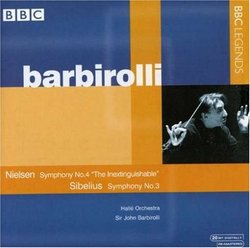| All Artists: Carl Nielsen, Jean Sibelius, John Barbirolli, Hallé Title: Nielsen: Symphony No. 4; Sibelius: Symphony No. 3 Members Wishing: 1 Total Copies: 0 Label: BBC Legends Original Release Date: 1/1/2007 Re-Release Date: 11/20/2007 Genre: Classical Styles: Historical Periods, Modern, 20th, & 21st Century, Symphonies Number of Discs: 1 SwapaCD Credits: 1 UPC: 684911422320 |
Search - Carl Nielsen, Jean Sibelius, John Barbirolli :: Nielsen: Symphony No. 4; Sibelius: Symphony No. 3
 | Carl Nielsen, Jean Sibelius, John Barbirolli Nielsen: Symphony No. 4; Sibelius: Symphony No. 3 Genre: Classical
|
Larger Image |
CD Details |
CD ReviewsBest tempi for the Nielsen musikwissenschaft | 03/09/2008 (5 out of 5 stars) "This is (I think) a reissue of a performance formerly available on vinyl LP through Vanguard; Barbirolli gets the mercurial tempo changes in the Nielsen (esp. in the first movement) better than anyone else. Compared with him, Bernstein is slow and clumping, and I do not think even Karajan's performance quite got it as right as Barbirolli. The sudden fast 'break' in the first movement is electrifying, as is the famous timpani solo later on. Most convincing rendition of the "Inextinguishable" I know of." Mostly for Fans of the Conductor and/or Live Performances Moldyoldie | Motown, USA | 01/07/2010 (3 out of 5 stars) "Both performances are recorded in live performance at London's Royal Albert Hall -- the Nielsen on July 30, 1965; the Sibelius on August 8, 1969, the year prior to Maestro Barbirolli's passing. Both exhibit the conspicuous audience rustling and dispersed coughing we've come to expect from BBC's welcome series of releases recorded from this venue. The stereo fidelity of the orchestra is decent enough and one easily adjusts to the unforgiving hall acoustic. Unfortunately, despite the very exuberant and affectionate applause which erupts spontaneously on their respective closing chords, I can't rightly say either performance measures up to the occasion.
Carl Nielsen's flamboyant Symphony No. 4 is arguably the most popular entry in the preeminent Danish composer's symphonic canon. Composed during the brutal depths of World War I, its seamless four movements expound on the dualities of war, culminating in the victory of man's ingenuity for creative good vis-à-vis the forces of its destruction; it presents many a rebus to the interpreter as well as pitfalls to the players. In the better performances I've heard, this music displays a subtle profoundness and even reverence amidst the rousing ballyhoo. Here, Barbirolli does strive for meaning behind the notes, but renders a performance with nary a truly memorable moment outside of the finale's hallmark tympani duel. We're guided through the thickets with an interpretation I can only describe as thoughtful and deliberate, but ill-measured and often plodding. Manchester's Hallé Orchestra, here sounding as scrappy a bunch as one will likely ever hear, admirably plow through some glaringly sour notes from the trombones and a few ensemble mishaps, not to mention a brass and bass-heavy balance exacerbated by undernourished violins, to effect a true sense of commitment and spontaneity. Still, a few iterations of the important three-note theme heard and alluded to throughout (which I shamelessly refer to as the "gotta dance" theme re Singin' in the Rain) are underplayed to the point of being nearly buried. Likewise, the dynamic clarion horn in the fourth movement (which I can't help but describe as Gershwinian; Nielsen adherents would rightly take exception and invoke the "which came first" argument) doesn't resound with the soul-stirring assurance I've come to expect, but rather with a disappointing lassitude and homogeneity -- this isn't supposed to sound like Sibelius, folks. Speaking of which... Barbirolli approaches the often enigmatic Sibelius Symphony No. 3 with the same slow deliberation I've heard recently from the likes of Colin Davis, probing for an elusive meaning that may not necessarily exist -- Barbirolli's first and second movements both exceed ten minutes. The finale, while effecting a nicely pointed crescendo-decrescendo at the movement's dynamic peak, eventually deteriorates into a wheel-spinning sonic morass lacking definition and musical coherence. To echo Emperor Joseph in Amadeus, is this modern? I much prefer more flowing, straightforward, and tuneful phrasing in this symphony, even at similarly slow tempi. Needless to say, I'm not as enamored of these performances as many reviewers I've read, including in UK's Gramophone, though I'm sure fans of either the conductor or of these two fine symphonies will be curious to hear this...as was I." |

 Track Listings (7) - Disc #1
Track Listings (7) - Disc #1